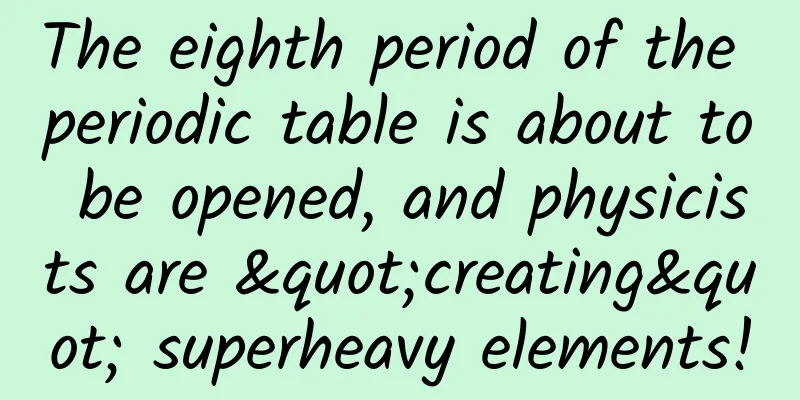The eighth period of the periodic table is about to be opened, and physicists are "creating" superheavy elements!

|
[Mobile software: Bo Ke Yuan] Physicists' measurements of collisions between small and large nuclei will provide information for the exploration of making new elements and may lead to new chemistry involving superheavy elements. Two tantalizing goals are almost within the grasp of experimental nuclear physicists. One is to break into the eighth period of the periodic table. So far, scientists have made all the elements of the first seven periods, from hydrogen (one proton) to gas (118 protons), so synthesizing heavier elements will break new ground. Another goal is to locate "islands of stability" in the sea of superheavy nuclei. Superheavy elements generally become less stable the more protons they contain. For example, the most stable isotope of niobium (113 protons) has a half-life of nearly 8 seconds, while Og has a half-life of just 0.7 milliseconds. But theorists believe that this trend will change for nuclei beyond Og. Physicists speculate that there is a particularly stable nucleus that has a magic number of protons and neutrons, a "double magic number." Long-lived superheavy elements would open up a new type of chemistry that includes reactions that take longer. To achieve these goals, experimentalists need to determine how to maximize the chances of producing superheavy nuclei, since it is estimated that it takes more than three months to synthesize a single atom. To do this, one needs to know the repulsion that two nuclei experience when they approach each other due to the attraction of the nuclear potential. Now, Taiki Tanaka of the RIKEN Nishida Center for Accelerator Science in Japan and colleagues have measured this repulsion by firing small nuclei (neon, magnesium and calcium) at large nuclei (plutonium and uranium) and measuring how they scatter. It was found that the repulsive barrier is mainly affected by the deformation of the larger nucleus shaped like a rugby ball. Comparison with the excitation functions for producing known superheavy elements shows that exciting smaller nuclei so that they are close to the side of the deformed larger nucleus will be the most effective strategy for producing new superheavy nuclei. If this trend holds true for heavier nuclei, then the optimal energy for smaller nuclei can be determined simply by measuring the repulsive barrier of the larger nucleus, which only takes about a day to complete. From this systematic study, the researchers proposed a new method to estimate the optimal incident energy required to synthesize new elements. The research team plans to use this knowledge to create new superheavy elements. In the short term, they will try to create new elements, such as element 119 or element 120. In one or two decades, they may reach the "island of stability", but they are not sure where it is. Using the gas-filled recoil ion separator for measurement, the quasi-elastic barrier distribution of these systems was extracted and compared with the results of coupled channel calculations. The results show that the barrier distribution is mainly affected by the deformation of the radon-based target nucleus, as well as by the vibrational or rotational excitation of the incident nucleus and the neutron migration process before capture. By comparing the experimental barrier distribution with the cross section of the evaporation residue, the thermal fusion reaction takes advantage of small collisions, when the incident particles approach along the short axis of the newly deformed nucleus. Bo Ke Yuan | Research/Source: RIKEN |
<<: Why do humans have to build a base on the moon? How to build it and when can it be completed?
>>: Can flying cars successfully take off into the sky?
Recommend
What else can happen besides rain?
What falls from the sky? Bugs? Birds? Is that a r...
Is it healthier to eat a midnight snack before going to bed than to go to bed hungry? Do you still dare to skip dinner?
One minute with the doctor, the postures are cons...
Healthy eating tips for families: Eat to stay healthy and improve immunity
Do you have a low immune system and the flu virus...
The most comprehensive iOS language learning materials collection
This learning material is prepared for iOS beginn...
Apple releases new iOS 12.3 beta: Improved speed and stability
Apple has released the fourth beta version of iOS...
How can Weibo advertising take advantage of the epidemic to revive?
“If you were given a room with a suitable tempera...
Can't resist the "sweet temptation"? Why not give it to "red, orange and green"?
This is the 4582nd article of Da Yi Xiao Hu News ...
How to operate a community? Information density is key!
The vast majority of communities are content prod...
These bad habits can lead to scoliosis, parents of primary and secondary school students must be vigilant!
《Cotton Swab Medical Science Popularization》 Capi...
A complete analysis of the Internet marketing plan
With the rapid development of mobile Internet, th...
Director Xiao’s Wealth Creation Circle 2.0: [Small and Beautiful Wealth Creation Circle], 108 scientific ways to create wealth
Director Xiao’s Wealth Creation Circle 2.0 [Small ...
Can “sad” music make people happy? I’m confused…
Scientists are intrigued by the fact that we can ...
Uncle Kai's Children's Financial Quotient Enlightenment Course
Uncle Kai's Children's Financial Quotient...
How to promote a new App?
Since I often write about App promotion, friends o...
How much does it cost to customize the Qiandongnan designated driver mini program?
The mini program provides convenience for publici...









